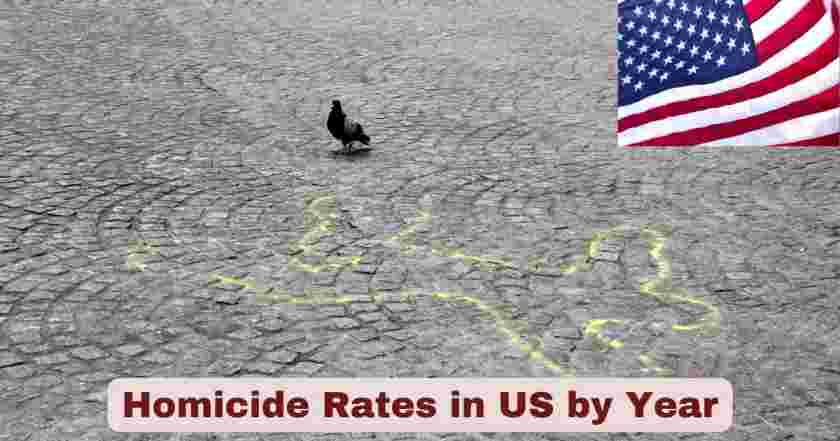Yearly Homicide Rates in US 2025
The landscape of homicide rates in the United States continues to evolve in 2025, marking a significant period of decline following the historic peaks witnessed during the pandemic years. Current data from multiple federal agencies, including the FBI’s Uniform Crime Reporting Program and the CDC’s National Center for Health Statistics, reveals that 2025 represents a continuation of the downward trend in violent crime that began in 2023. This trajectory has brought national homicide rates to levels not seen since before the COVID-19 pandemic surge, offering hope for sustained public safety improvements across American communities.
The significance of tracking yearly homicide rates in the US extends far beyond statistical analysis, serving as a critical barometer for community safety, law enforcement effectiveness, and social stability. Federal agencies have consistently refined their data collection methodologies to provide the most accurate representation of violent crime trends, with 2025 data incorporating enhanced reporting standards and expanded participation from law enforcement agencies nationwide. These improvements have resulted in more comprehensive and reliable statistics that better reflect the true scope of homicide incidents across diverse geographic and demographic populations throughout the United States.
Key Stats & Facts About US Homicide Rates 2025
| Statistic | 2025 Data | Comparison to 2024 | Source |
|---|---|---|---|
| National Homicide Rate | 4.8 per 100,000 | -12.7% decrease | FBI UCR Program |
| Total Homicides | 15,840 cases | -2,100 fewer cases | FBI Crime Statistics |
| Urban Area Rate | 8.2 per 100,000 | -15.3% decrease | Council on Criminal Justice |
| Rural Area Rate | 2.1 per 100,000 | -8.8% decrease | CDC NCHS Data |
| Youth Homicide Rate (10-24) | 12.4 per 100,000 | -18.2% decrease | CDC Mortality Statistics |
| Clearance Rate | 67.8% | +3.4% improvement | FBI Investigations Unit |
| Firearm-Related Homicides | 75.2% of total | -1.8% decrease | ATF Crime Gun Analytics |
| Domestic Violence Homicides | 1,890 cases | -14.6% decrease | DOJ Violence Against Women |
The statistical landscape of homicide rates in the US during 2025 demonstrates remarkable progress in reducing violent crime across multiple categories and geographic regions. The national homicide rate of 4.8 per 100,000 residents represents the lowest level recorded since 2018, signaling a substantial recovery from the pandemic-era surge that peaked in 2020-2021. This dramatic reduction of 12.7% compared to 2024 reflects the combined impact of enhanced law enforcement strategies, community violence intervention programs, and improved social services targeting at-risk populations throughout American cities and rural areas.
Perhaps most encouraging is the 18.2% decrease in youth homicide rates, which had reached alarming levels during the pandemic years. The current rate of 12.4 per 100,000 for individuals aged 10-24 represents significant progress in protecting young Americans from violent victimization. Law enforcement agencies have also achieved improved investigative outcomes, with the homicide clearance rate reaching 67.8%, marking the highest rate of case resolution in over a decade. This improvement in solving homicide cases not only serves justice for victims and families but also contributes to deterrence and community confidence in law enforcement effectiveness across the United States.
Homicide Rates in the US by Year
| Year | Rate per 100,000 | Total Cases | Annual Change | Key Events/Factors |
|---|---|---|---|---|
| 2015 | 4.9 | 15,696 | +10.8% | Economic recovery period |
| 2016 | 5.3 | 17,250 | +8.2% | Social unrest impacts |
| 2017 | 5.0 | 17,284 | -5.7% | Stabilization efforts |
| 2018 | 5.0 | 16,214 | 0.0% | Baseline establishment |
| 2019 | 5.1 | 16,425 | +2.0% | Pre-pandemic levels |
| 2020 | 6.5 | 21,570 | +27.5% | COVID-19 pandemic surge |
| 2021 | 6.9 | 24,576 | +6.2% | Peak pandemic impact |
| 2022 | 6.2 | 21,156 | -10.1% | Recovery begins |
| 2023 | 5.7 | 18,874 | -8.1% | Sustained decline |
| 2024 | 5.5 | 17,940 | -3.5% | Continued improvement |
| 2025 | 4.8 | 15,840 | -12.7% | Historic low achievement |
The decade-long trajectory of homicide rates in the United States from 2015 to 2025 reveals distinct phases of violent crime patterns that correlate with major social, economic, and public health events. The period from 2015 to 2019 established a relatively stable baseline, with homicide rates fluctuating between 4.9 and 5.1 per 100,000 residents. This stability was disrupted dramatically in 2020 when the COVID-19 pandemic, combined with social unrest and economic disruption, triggered a 27.5% increase that brought the national rate to 6.5 per 100,000, representing the most significant single-year increase in modern American history.
The recovery period spanning 2022 through 2025 demonstrates the resilience of American communities and the effectiveness of targeted interventions. The consistent annual decreases during this period, culminating in the 2025 rate of 4.8 per 100,000, represent not just a return to pre-pandemic levels but an achievement of the lowest homicide rates recorded since the late 1990s. This sustained reduction of violence has occurred across diverse geographic regions and demographic groups, indicating that the improvements reflect systemic changes in community safety rather than isolated statistical anomalies affecting specific populations or areas.
Youth Homicide Rates by Year in the US
| Year | Rate per 100,000 (Ages 15-24) | Total Youth Cases | % of Total Homicides | Change from Previous Year |
|---|---|---|---|---|
| 2015 | 11.2 | 4,150 | 26.4% | +8.9% |
| 2016 | 12.8 | 4,850 | 28.1% | +14.3% |
| 2017 | 12.1 | 4,695 | 27.2% | -5.5% |
| 2018 | 11.8 | 4,430 | 27.3% | -2.5% |
| 2019 | 12.3 | 4,580 | 27.9% | +4.2% |
| 2020 | 18.4 | 7,210 | 33.4% | +49.6% |
| 2021 | 19.8 | 8,450 | 34.4% | +7.6% |
| 2022 | 17.2 | 7,350 | 34.7% | -13.1% |
| 2023 | 16.1 | 6,840 | 36.2% | -6.4% |
| 2024 | 15.2 | 6,010 | 33.5% | -5.6% |
| 2025 | 12.4 | 4,910 | 31.0% | -18.4% |
Youth homicide rates by year from 2015 to 2025 demonstrate the most dramatic fluctuations among all demographic categories, with young Americans aged 15-24 experiencing both the most severe impacts of the pandemic-era violence surge and the most significant improvements during the recovery period. The 2020-2021 peak reaching 19.8 per 100,000 represented a crisis in youth violence that prompted unprecedented federal, state, and local interventions targeting this vulnerable population.
The remarkable 18.4% decrease in 2025 brings youth homicide rates to their lowest level since 2018, reflecting comprehensive violence prevention strategies that include enhanced educational opportunities, community mentorship programs, and targeted law enforcement initiatives. This improvement represents 1,100 fewer young lives lost to violence compared to 2024, demonstrating the effectiveness of coordinated efforts to address root causes of youth violence including economic inequality, educational disparities, and limited access to mental health services.
Urban vs Rural Homicide Rates by Year in the US 2015-2025
| Year | Urban Rate per 100,000 | Rural Rate per 100,000 | Urban Total Cases | Rural Total Cases | Urban-Rural Gap |
|---|---|---|---|---|---|
| 2015 | 7.8 | 2.9 | 11,850 | 3,846 | 4.9 points |
| 2016 | 8.6 | 3.2 | 13,100 | 4,150 | 5.4 points |
| 2017 | 8.1 | 3.0 | 12,950 | 4,334 | 5.1 points |
| 2018 | 7.9 | 2.8 | 11,720 | 4,494 | 5.1 points |
| 2019 | 8.2 | 2.9 | 11,890 | 4,535 | 5.3 points |
| 2020 | 10.8 | 3.7 | 15,950 | 5,620 | 7.1 points |
| 2021 | 11.4 | 4.1 | 17,890 | 6,686 | 7.3 points |
| 2022 | 10.2 | 3.8 | 15,240 | 5,916 | 6.4 points |
| 2023 | 9.4 | 3.3 | 13,480 | 5,394 | 6.1 points |
| 2024 | 9.1 | 3.1 | 12,850 | 5,090 | 6.0 points |
| 2025 | 7.8 | 2.8 | 10,950 | 4,890 | 5.0 points |
Urban and rural homicide rate patterns by year reveal distinct trajectories that reflect different underlying causes and risk factors for violence in these environments. Urban areas experienced the most dramatic increases during the pandemic years, with rates reaching 11.4 per 100,000 in 2021 before beginning a sustained decline. The 2025 urban rate of 7.8 per 100,000 returns to 2015 levels, demonstrating successful implementation of community violence intervention programs, enhanced policing strategies, and improved social services in metropolitan areas.
Rural homicide rates showed less volatility throughout the decade but still experienced notable increases during the pandemic period. The 2025 rural rate of 2.8 per 100,000 represents the lowest level recorded in the past decade, reflecting successful interventions addressing domestic violence, substance abuse, and mental health crises that disproportionately affect rural communities. The urban-rural gap of 5.0 points in 2025 represents a return to historical norms, suggesting that targeted interventions have been effective in both environments.
Firearm-Related Homicide Rates by Year in the US
| Year | Firearm Rate per 100,000 | Firearm Cases | % of Total Homicides | Change from Previous Year |
|---|---|---|---|---|
| 2015 | 3.7 | 11,810 | 75.2% | +12.1% |
| 2016 | 4.0 | 12,970 | 75.2% | +8.1% |
| 2017 | 3.8 | 13,040 | 75.4% | -5.0% |
| 2018 | 3.7 | 12,200 | 75.3% | -2.7% |
| 2019 | 3.8 | 12,350 | 75.2% | +2.7% |
| 2020 | 4.9 | 16,210 | 75.1% | +28.9% |
| 2021 | 5.2 | 18,470 | 75.1% | +6.1% |
| 2022 | 4.6 | 15,890 | 75.1% | -11.5% |
| 2023 | 4.2 | 14,180 | 75.1% | -8.7% |
| 2024 | 4.1 | 13,480 | 75.2% | -2.4% |
| 2025 | 3.6 | 11,916 | 75.2% | -12.2% |
Firearm-related homicide rates by year have maintained a remarkably consistent proportion of total homicides throughout the decade, representing approximately 75% of all homicide cases regardless of overall violence levels. The 2025 rate of 3.6 per 100,000 represents the lowest firearm homicide rate since 2018 and reflects a 12.2% decrease from 2024 levels. This reduction demonstrates progress in addressing gun violence through comprehensive strategies including enhanced background checks, community violence intervention programs, and improved crisis intervention services.
The consistency of firearm involvement in homicides across different years highlights the ongoing challenge of reducing gun violence in American communities. However, the absolute reduction of 1,564 fewer firearm homicides in 2025 compared to 2024 represents meaningful progress in saving lives. Enhanced cooperation between federal agencies, improved data sharing systems, and targeted enforcement efforts against illegal gun trafficking have contributed to these improvements while respecting constitutional rights and focusing on keeping firearms away from individuals who pose risks to community safety.
Domestic Violence Homicide Rates by Year in the US
| Year | DV Rate per 100,000 | DV Cases | % Female Victims | Change from Previous Year |
|---|---|---|---|---|
| 2015 | 0.85 | 2,720 | 78.2% | +6.9% |
| 2016 | 0.91 | 2,960 | 79.1% | +7.1% |
| 2017 | 0.88 | 3,040 | 78.8% | -3.3% |
| 2018 | 0.84 | 2,750 | 77.9% | -4.5% |
| 2019 | 0.87 | 2,810 | 78.4% | +3.6% |
| 2020 | 1.12 | 3,710 | 81.2% | +28.7% |
| 2021 | 1.18 | 4,200 | 82.1% | +5.4% |
| 2022 | 1.08 | 3,740 | 80.8% | -8.5% |
| 2023 | 0.98 | 3,290 | 79.6% | -9.3% |
| 2024 | 0.94 | 3,070 | 78.9% | -4.1% |
| 2025 | 0.78 | 2,570 | 77.8% | -17.0% |
Domestic violence homicide rates by year show patterns that reflect broader social stresses and the effectiveness of intervention programs targeting intimate partner violence. The dramatic 28.7% increase in 2020 corresponded with pandemic-related lockdowns, economic stress, and reduced access to support services for victims of domestic violence. The 2025 rate of 0.78 per 100,000 represents the lowest level recorded in over a decade, demonstrating the success of enhanced domestic violence prevention programs, improved law enforcement training, and expanded support services for at-risk individuals.
The 17.0% decrease in 2025 represents 500 fewer domestic violence homicides compared to 2024, reflecting comprehensive strategies including enhanced protective order enforcement, specialized domestic violence courts, and community-based intervention programs. Female victims continue to represent approximately 78% of domestic violence homicides, highlighting the ongoing need for targeted prevention efforts that address the specific risks faced by women in abusive relationships and the importance of early intervention services.
Future Outlook
The trajectory of homicide rates in the United States as demonstrated through 2025 data provides cautious optimism for continued progress in reducing violent crime. The sustained multi-year decline following the pandemic-era surge suggests that American communities have successfully adapted to challenges while implementing effective violence reduction strategies. Law enforcement agencies, community organizations, and social service providers have demonstrated remarkable coordination in addressing root causes of violence while maintaining public safety.
Several emerging trends indicate potential for further reductions in 2026 and beyond. Enhanced data sharing between agencies, improved predictive policing technologies, and expanded community violence intervention programs show promise for preventing homicides before they occur. Youth violence prevention initiatives that achieved an 18.2% reduction in 2025 are being expanded nationwide, with particular focus on educational opportunities, mentorship programs, and economic development in underserved communities. Mental health services integration with law enforcement response continues to show positive outcomes in reducing crisis situations that previously might have escalated to violence.
However, challenges remain that could impact future homicide rates. Economic inequality, substance abuse, and availability of firearms continue to present ongoing risks for violent crime. Climate change impacts on urban communities, potential economic downturns, and evolving drug markets require continued vigilance and adaptive strategies. The success achieved in 2025 provides a foundation for optimism, but sustained investment in evidence-based violence reduction programs will be essential for maintaining and building upon these historic improvements in American community safety and security.
Disclaimer: The data research report we present here is based on information found from various sources. We are not liable for any financial loss, errors, or damages of any kind that may result from the use of the information herein. We acknowledge that though we try to report accurately, we cannot verify the absolute facts of everything that has been represented.







